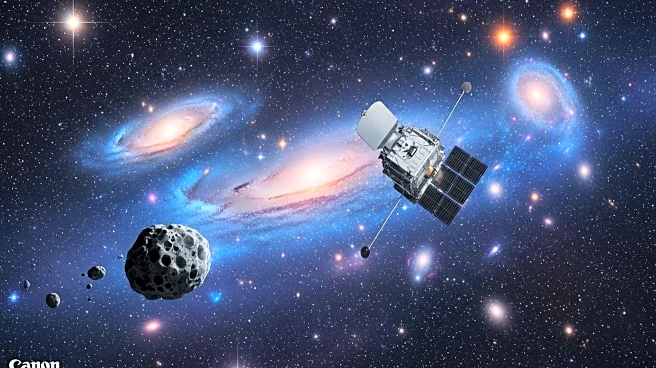What is the story about?
What's Happening?
The Hubble Space Telescope recently captured an image of the spiral galaxy NGC 6000, located 102 million light-years away in the constellation Scorpius. While the telescope was searching for supernova explosions, it unexpectedly recorded the path of an asteroid streaking across its field of view. The image reveals the life cycles of stars within the galaxy, with older, cooler stars at the center and younger, hotter stars in the spiral arms. The asteroid's path appears as faint broken lines due to the use of red and blue filters during the imaging process. This discovery adds a new layer of interest to the ongoing study of NGC 6000 and the phenomena within it.
Why It's Important?
The unexpected capture of an asteroid by the Hubble Space Telescope highlights the dynamic and unpredictable nature of space exploration. This event underscores the importance of continuous observation and the potential for serendipitous discoveries that can provide new insights into the cosmos. The ability to observe both supernovas and asteroids in a single image demonstrates the versatility and enduring value of the Hubble Telescope, even as it ages. Such discoveries can inform future missions and the development of new technologies for space observation, benefiting scientific research and expanding our understanding of the universe.
What's Next?
The findings from the Hubble Telescope's latest observations may prompt further studies into the behavior and characteristics of asteroids within distant galaxies. Researchers might explore the implications of these observations for understanding the formation and evolution of galaxies. Additionally, the data collected could be used to refine models of stellar life cycles and the interactions between different celestial bodies. As the Hubble continues to operate, it may uncover more unexpected phenomena, contributing to the broader field of astronomy and potentially guiding future space missions.
Beyond the Headlines
The discovery of the asteroid in the Hubble's field of view raises questions about the frequency and impact of such occurrences in space exploration. It highlights the need for adaptive strategies in observational astronomy, where unexpected events can provide valuable data. This incident also illustrates the interconnectedness of various celestial phenomena and the importance of comprehensive approaches to studying the universe. The ability to capture diverse elements in a single observation may lead to new methodologies in space research, enhancing our ability to interpret complex cosmic interactions.
AI Generated Content
Do you find this article useful?














